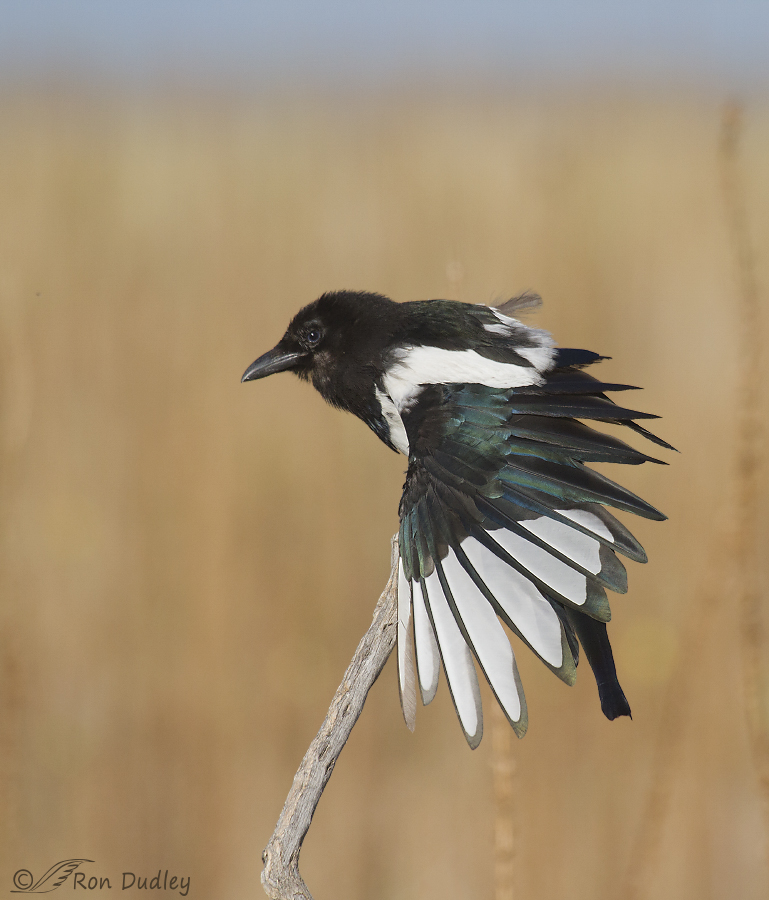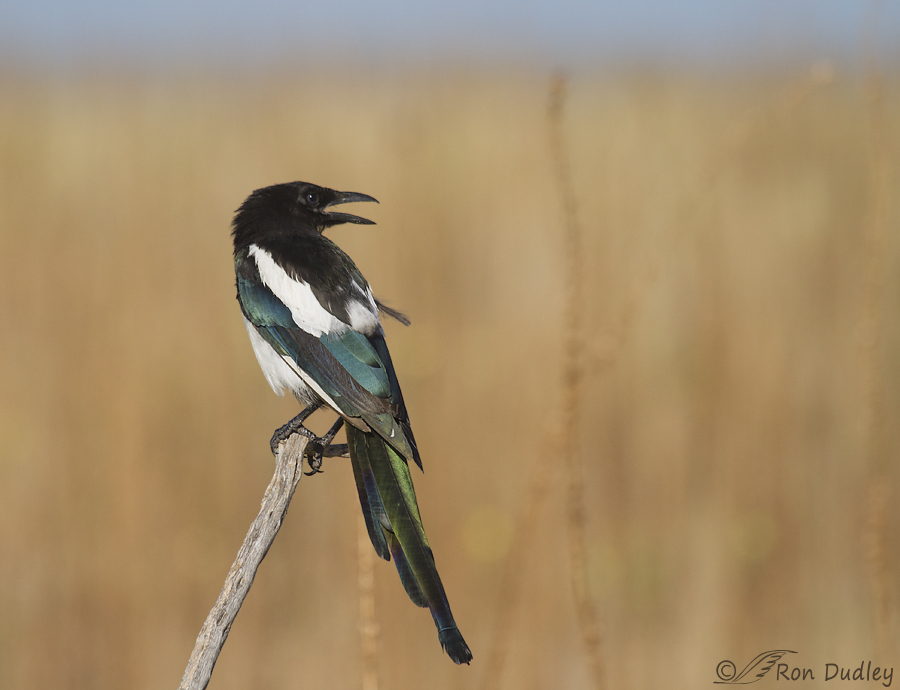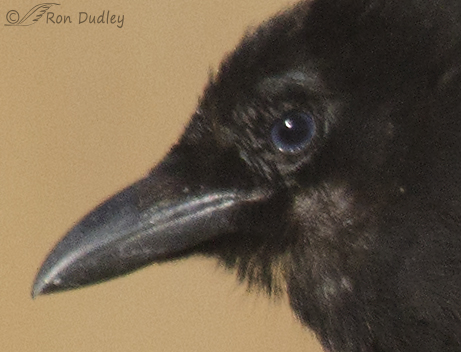Juvenile Black-billed Magpies have significantly less iridescence in their plumage than the adults so the amount that appeared in this young bird surprised me.

1/2000, f/6.3, ISO 500, Canon 7D, Canon EF100-400mm f/4.5-5.6L IS USM @ 400 mm, not baited, set up or called in
The juvenile was perched near the group campground on Antelope Island a week ago and it let me get unusually close so I switched to my zoom lens. Even at that distance it was comfortable enough to give me a wing stretch and when it did the sun angle was just right for some iridescence to appear, even in a juvie.

1/2000, f/6.3, ISO 500, Canon 7D, Canon EF100-400mm f/4.5-5.6L IS USM @ 400 mm, not baited, set up or called in
And when it turned to take off away from me even more iridescence appeared, more than I recall ever seeing in a juvenile previously.
Magpies at this stage show considerably more variations in plumage than do the adults (size and shape of white wing patches and the length of dark tips on flight feathers for example). It’s now that they’re forming a variety of complex bonds and it’s thought that those variations allow them to recognize individuals so that those bonds can be formed.
Social status and dominance are also being established at this stage and that also requires individual recognition. Some young males even pull the tails of predatory birds like Cooper’s Hawks and Northern Goshawks in a daring act of bravado that is thought to increase social status.
Can you imagine? A goshawk! Reminds me of a magpie version of “the running of the bulls” in Pamplona, Spain…
Ron
Addendum: I’m posting this heavily cropped version of the first image to better show eye color in response to the question below from Louise Shimmel.



I think that unscientific, overall “look” you refer to is known as the “cuteness factor”. Oops, sorry, did I just say that?
Love the “running of the bulls” comment.Fits the magpie nature to a “T”.I will have to check the eye colour in the future. Most of the young here still have their short tail. Great shots of the colours, every time I write about magpies , I have to get the dictionary out to look up the word, “iridescence.”
Ah, yes! I see that. We do have a permanent resident magpie here and I have had one previously for 12 years; they both had some pretty heavy molts which made them look rather scruffy and the tail is quite a bit shorter until the long central feathers grow back in. So I wondered – thought maybe you’d also seen him begging. I also don’t know when they lose the remnants of gape flanges – I know crows don’t keep them as long as some of the cavity nesters. Still not sure why that one primary would be shorter – but, hey! Just curious. I do love those magpies!
I always appreciate your input, Louise and this time you really made me think about whether or not I’d made the right call. Nothing wrong with “curiosity” and I love those magpies too!
Ron – I’m wondering how you were sure this was a juvenile? They don’t breed on this side of the Cascades here in Oregon, so I can’t say I’ve seen youngsters much – but I’m wondering if they might not have blue eyes and red inside their mouths like crows and ravens. Also, in the first shot, the primaries are not even – like the next to the last one is just molting in, which would indicate an adult. Same for the tail. Most young birds grow ALL their flight feathers and the whole tail at the same time, as I’m sure you know. I know magpies’ tail feathers are differing lengths, though – so I’m not sure. But was wondering what identified him to you as a juvie and if he was just a scruffy adult, perhaps that would explain the iridescence.
Louise, I’m certainly no expert but this bird sure looks like a hatch-year bird to me. It’s tail is noticeably shorter than that of an adult and its iris appears to me to be the “pale gray to bluish-gray” one would expect in hatch-year birds their first summer and fall (see huge crop of the first photo I’ve added, above). Juveniles also have patches of almost bare skin on their faces that can be seen in the added, cropped photo. Those feathers don’t fill in until about January of their first year. We can’t see the color of the mouth lining. I know very little about molting patterns so I didn’t use that factor in my determination. And to me this bird definitely has the overall look of a juvie (unscientific, I know). Right or wrong, that’s how made the call…
I am always fascinated (I use that word a lot here) at just how different ‘your’ magpies are. And then learn that they share some character traits with ours. Our magpies (young and old) are feisty charmers. And sometimes brave beyond the point of foolhardiness.
Gorgeous images – thank you.
Running of the bulls? Crowd induced courage (and insanity). And I feel for the bulls soooooo much more than for the humans involved.
For those wondering, Elephant’s Child’s magpies are Australian Magpies (Cracticus tibicen) and I don’t believe that they are technically corvids but it sure sounds like they share some behaviors with our magpies.
The tail=pulling makes me think of college frat hazing. He is a stunning example of his species.
Sadly, humans have multiple practices that can be compared to the tail-pulling, Arwen.
Ron. The Gos probably thought it was a joke.
Thanks for the photos and description
If so it’s a good thing for the magpie that they have a sense of humor about it, Diana…
Thank you for today’s lesson. I did not know that. It is very interesting.
I understand your point of vue on the “magpie version…” but here is a matter of acquiring social status and in Pamplona is total madness.
An interesting comparison of the practice between Portugal and Spain, Jorge.
I’m glad that this young one gave you a good opportunity to capture the iridescence, since it’s not always easy to catch.
Thanks, Susan.
He’s a beauty already…very interesting about bonding and recognition via physical characteristics, and social status gained through adolescent “macho” behaviours. I wonder if the showoff stuff is particularly evident in corvids. I raised a crow that used to like to pull our dog’s tail. Now I wonder why.
I’ll bet you’re right about corvids in general, Patty – to one degree or another.
Wonderful shots Ron!
Charlotte
Thanks, Charlotte.